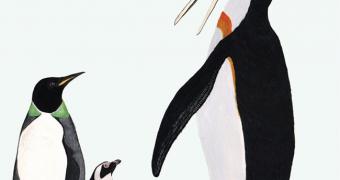Most penguins are a little bigger than a duck, with some exceptions, but their prehistoric cousins were much larger and unlike modern ice-loving species, they might have basked in a warm beach on the Peruvian coast over 30 million years ago, as two fossils suggest.
One species had a seven-inch (18 cm) beak, was 5 ft (1.5 m) tall, dwarfing the largest today's species, the Emperor penguin, which can be 4 ft (1.2 m) tall and weigh 30 kg (84 pound). The nowadays 18 penguin species vary in size, from the three-pound (1.2 kg) and 16-inch (38 cm) little blue penguin to the Emperor penguin.
The skeletons of the warm-clime fossil penguins point they were deep divers and could swim with the same agility as nowadays species. This contradicts the idea that penguins evolved in high latitudes and only 10 million years ago, when the Earth cooled significantly, they crossed the Equator.
"We tend to think of penguins as being cold-adapted species. But the new fossils date back to one of the warmest periods in the last 65 million years of Earth's history. The evidence indicates that penguins reached low-latitude regions more than 30 million years prior to our previous estimates." said lead author Julia Clarke, a paleontologist at North Carolina State University and the North Carolina Museum of Natural Sciences.
"We had known from isolated bones and limited material an array of giant penguin species from high-latitude regions, but none from low latitudes." Clarke told LiveScience.
The new species' bones had been found in 2005 along the southern coast of Peru. The giant penguin, Icadyptes salasi lived about 36 million years ago, while the smaller species, Perudyptes devriesi, 2.5 to 3 ft (80-90 cm) tall, one of the oldest discovered penguin species, lived about 42 million years ago.
The ancient beaks were also unusual due to their extremely long, narrow spear-like beaks.
"It likely helped the animal gulp down large prey and attain its towering stature." said Clarke.
Perudyptes's features show an evolution from wing to paddle; its wing muscles were atrophied, "which basically are part of the changes to get to a paddle-like structure--you reduce these intrinsic wing muscles," Clarke said.
Despite their specific aspect and biology (which impeded for long the zoologists to make a connection between penguins and other birds species), they are in fact related to one of the best flying birds of the ocean, as showed by DNA analysis: frigatebirds, loons (divers), albatrosses, petrels and shearwaters.
The two Peruvian species are the result of two separate dispersals, Perudyptes rooting in Antarctica before crossing the Equator and Icadyptes near New Zealand.
Some wonder if these species do not show the penguin's ability to adapt to the warming sea.
"We are not by these findings implying that extant penguins will not be affected by current global warming. These Peruvian species are early branches off the penguin family tree, that are comparatively distant cousins of living penguins," Clarke said. "In addition, current global warming is occurring on a significantly shorter timescale. The data from these new fossil species cannot be used to argue that warming wouldn't negatively impact living penguins."
The largest fossil penguin, Pachydyptes, was found in New Zealand: it was 1.6 m (5.5 ft) tall and weighed probably 80-100 kg (180-220 pounds) and it was of the same age with Icadyptes. The older Anthropornis from Antarctica was older, 1.7 m (5.8 ft) tall and weighed about 90 kg.
Today Peru's only penguin is the Humboldt penguin, a dwarf 68 cm (2 ft) tall weighing 4 kg (9 pounds).

 14 DAY TRIAL //
14 DAY TRIAL //